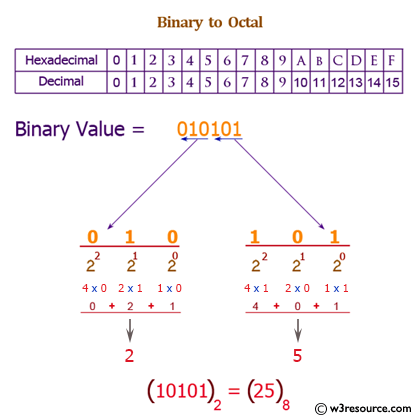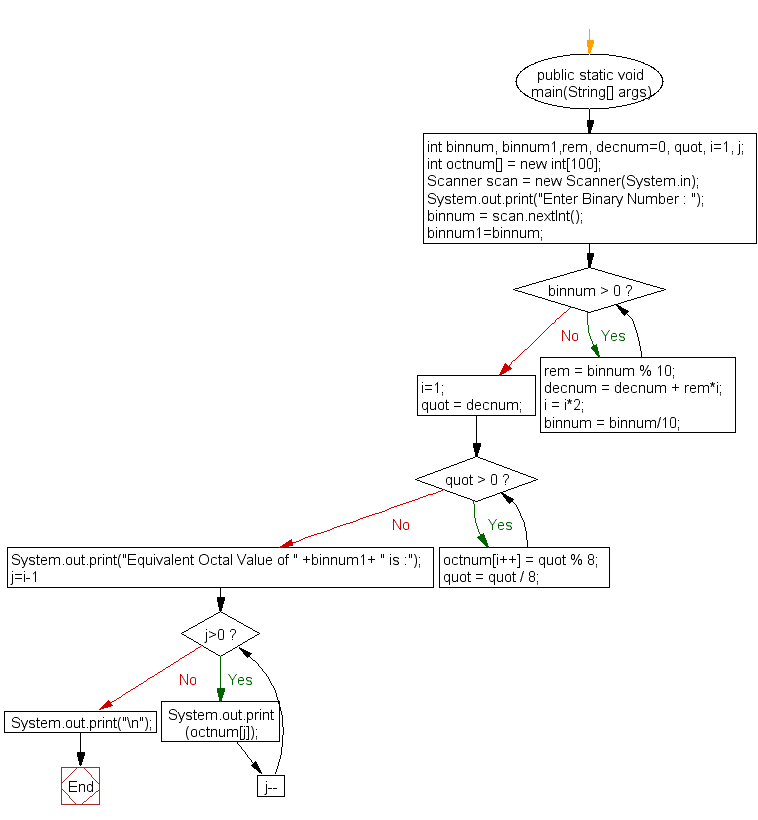Java: Convert a binary number to a Octal number
Binary to Octal Converter
Write a Java program to convert a binary number to an octal number.
Binary number: A binary number is a number expressed in the base-2 numeral system or binary numeral system. This system uses only two symbols: typically 0(zero) and 1(one).
Octal number: The octal numeral system is the base-8 number system, and uses the digits 0 to 7.
Test Data:
Input a binary number: 111
Pictorial Presentation: Binary to Octal number

Sample Solution:
Java Code:
import java.util.*;
public class Exercise24 {
public static void main(String[] args) {
// Declare variables to store binary and decimal numbers, remainder, quotient, and an array for octal digits
int binnum, binnum1, rem, decnum = 0, quot, i = 1, j;
int octnum[] = new int[100];
// Create a Scanner object to read input from the user
Scanner scan = new Scanner(System.in);
// Prompt the user to input a binary number
System.out.print("Input a Binary Number : ");
binnum = scan.nextInt();
binnum1 = binnum;
// Convert the binary number to decimal
while (binnum > 0) {
rem = binnum % 10;
decnum = decnum + rem * i;
i = i * 2;
binnum = binnum / 10;
}
i = 1;
quot = decnum;
// Convert the decimal number to octal
while (quot > 0) {
octnum[i++] = quot % 8;
quot = quot / 8;
}
// Display the equivalent octal value of the original binary number
System.out.print("Equivalent Octal Value of " + binnum1 + " is :");
for (j = i - 1; j > 0; j--) {
System.out.print(octnum[j]);
}
System.out.print("\n");
}
}
Explanation:
In the exercise above -
- First, initialize an array 'octnum' to store the octal digits of the converted number and other necessary variables.
- It takes a binary number as input from the user using the "Scanner" class and stores it in the variable 'binnum'.
- Next it enters a loop to convert the binary number to decimal:
- In each iteration, it calculates the remainder when 'binnum' is divided by 10 (which gives the least significant binary digit).
- It adds this remainder multiplied by i to the 'decnum' variable to accumulate the decimal value.
- It multiplies 'i' by 2 to prepare for the next binary digit.
- It updates 'binnum' by removing the least significant digit (rightmost) and by dividing it by 10.
- The loop continues until 'binnum' becomes zero, effectively converting the entire binary number to decimal.
- After converting to decimal, it enters another loop to convert the decimal number to octal:
- In each iteration, it calculates the remainder when 'decnum' is divided by 8 (which gives the least significant octal digit).
- It stores this remainder in the 'octnum' array.
- It updates 'decnum' by dividing it by 8 to move to the next octal digit.
- Finally, it prints the octal representation of the original binary number by iterating through the 'octnum' array in reverse order.
Sample Output:
Enter Binary Number : 111 Equivalent Octal Value of 111 is :7
Flowchart:

For more Practice: Solve these Related Problems:
- Convert a binary number longer than 12 bits to octal.
- Modify the program to accept user input for multiple binary numbers at once.
- Write a program to perform binary-to-octal conversion using bitwise operations.
- Implement binary-to-octal conversion recursively.
Go to:
PREV : Binary to Hexadecimal Converter.
NEXT : Octal to Decimal Converter.
Java Code Editor:
What is the difficulty level of this exercise?
Test your Programming skills with w3resource's quiz.
